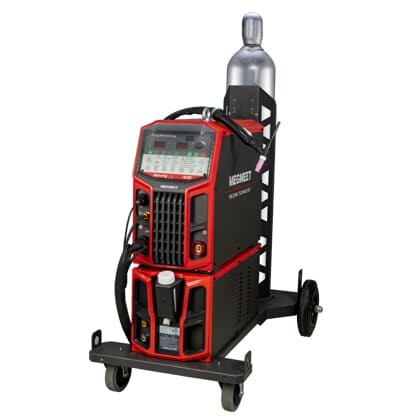In the realm of welding, the Tungsten Inert Gas (TIG) welding method stands out for its precision, cleanliness, and versatility. While commonly associated with intricate welds and fine details, TIG welding also finds its place in spot welding applications, offering unique advantages over other methods. In this comprehensive guide, we delve into the why and how of spot welding with a TIG welder, exploring techniques, benefits, and the remarkable capabilities of the Megmeet MetaTIG HF ACDC/DC TIG welder.
 effect.jpg)
I. Basics of TIG for Spot Welding.
TIG welding employs a non-consumable tungsten electrode to create the weld, while a shielding gas, typically argon, protects the weld area from atmospheric contamination. Spot welding with TIG involves the controlled application of heat to specific points, fusing materials without the need for filler metal.
II. Why Choose TIG for Spot Welding?
Precision: TIG welding offers unparalleled precision, making it ideal for spot welding applications where accuracy is paramount. The ability to control heat input ensures consistent, high-quality welds, even in delicate materials.
Cleanliness: Unlike other welding methods, TIG produces minimal spatter and smoke, resulting in cleaner welds and reduced post-weld cleanup. This is particularly advantageous when working on projects that demand pristine finishes.
Versatility: TIG welding can handle a wide range of materials, including stainless steel, aluminum, copper, and titanium, making it suitable for diverse spot welding needs across various industries.
III. How to Spot Weld with a TIG Welder?
Spot welding with a TIG welder requires precision, patience, and a firm understanding of welding fundamentals. Here's a step-by-step guide to mastering the technique:
Prepare Your Workspace: Ensure your work area is clean, well-ventilated, and free from any flammable materials. Secure the materials to be welded in a stable position, minimizing movement during the welding process.
Select the Right Equipment: Invest in a reliable TIG welding machine equipped with spot welding capabilities, such as the Megmeet MetaTIG HF ACDC/DC TIG welder. This advanced machine offers precise control over welding parameters, ensuring optimal results.

Choose the Correct Electrode and Shielding Gas: Select an appropriate tungsten electrode based on the material you're welding. For instance, use pure tungsten for aluminum and thoriated tungsten for steel. Additionally, ensure the shielding gas matches the material being welded for optimal protection and weld quality.
Set the Welding Parameters: Adjust the welding current, arc length, and travel speed according to the material thickness and desired weld characteristics. Experiment with different settings to achieve the perfect balance of penetration and heat control.
Position the Torch and Initiate the Arc: Position the TIG torch at the desired spot weld location, maintaining a consistent angle and distance from the workpiece. With a steady hand, initiate the arc by striking the tungsten electrode against the workpiece, then quickly withdraw to establish the welding arc.
Control Heat Input: Control the heat input by modulating the foot pedal or amperage control on the TIG welder. Apply short bursts of current to create localized heat, gradually building up the weld pool without overheating the surrounding area.
Monitor Weld Pool and Progress: Keep a close eye on the weld pool formation and overall progress of the spot weld. Adjust welding parameters as needed to maintain proper fusion and prevent defects such as burn-through or lack of penetration.
Complete the Weld: Once the spot weld is complete, gradually reduce the welding current and allow the weld to cool naturally. Inspect the weld for any imperfections and make necessary adjustments for subsequent spot welds.
IV. Megmeet MetaTIG HF ACDC/DC TIG Welder: Unleash Precision
For professionals and enthusiasts alike, the Megmeet MetaTIG HF ACDC/DC TIG welder represents the pinnacle of TIG welding technology. With its advanced features and superior performance, this welder empowers users to tackle spot welding challenges with confidence and precision.
V. Key Features of the Megmeet MetaTIG HF ACDC/DC TIG Welder:
Dual Voltage Capability: Seamlessly switch between AC and DC welding modes, catering to a wide range of materials and applications.
High-Frequency Start: Ensures smooth arc initiation and minimal tungsten contamination, enhancing weld quality and consistency.
Pulse Welding Function: Enables precise control over heat input and weld bead appearance, perfect for spot welding thin materials and intricate components.
Digital Display and Programmable Settings: Allows users to fine-tune welding parameters with precision and ease, optimizing weld performance and efficiency.
Robust Construction and Reliability: Built to withstand the rigors of industrial welding environments, ensuring years of dependable service and performance.
VI. Conclusion
Spot welding with a TIG welder opens up a world of possibilities for welders seeking precision, cleanliness, and versatility in their projects. By harnessing the power of the Megmeet MetaTIG HF ACDC/DC TIG welder and mastering the techniques outlined in this guide, you can elevate your welding capabilities to new heights. Whether you're fabricating intricate components or joining dissimilar materials, TIG spot welding offers unmatched quality and control, making it a valuable skill for welders across industries.
For more information about the Megmeet MetaTIG HF ACDC/DC TIG welder and other welding solutions, visit Megmeet Welding and explore the MetaTIG ACDC Welder Series here. Master the art of TIG spot welding and unleash your full potential as a welder.
Related articles:
1. Spot Welding vs. TIG Welding vs. MIG Welding: Differences & How to Choose?
2. What is Spot Welding? (A Complete Welding Process Guide)
3. Spot Size, Laser Quality and Welding Performance
4. The Most Complete TIG Welding Basics
5. Robotic TIG Welding Improves Speed, Quality, and Efficiency



 effect.jpg)

